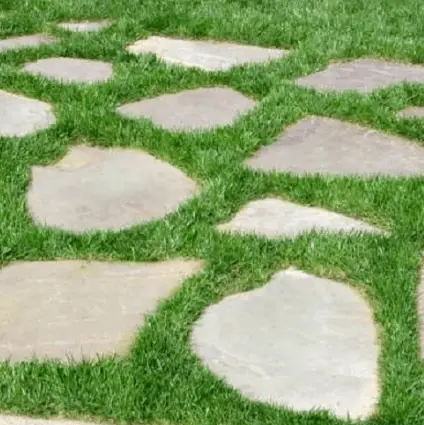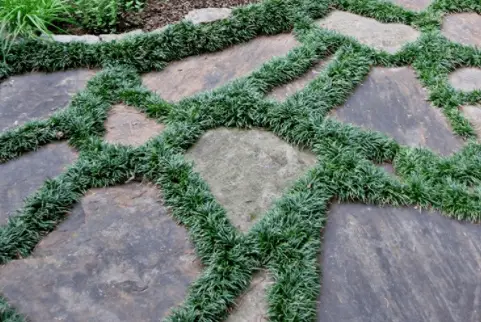Pavers offer a simple yet effective solution for creating patios, sidewalks, and walking paths. They are not only inexpensive but also simple to install and maintain. However, adding some grass between pavers creates a natural blend that makes your home’s exteriors very attractive.

Not only is this beautiful, but it also prevents unwanted weeds growing in the spaces between pavers.
Further, grass between pavers prevents soil erosion caused by surface runoff and winds.
In details, let us look at how to grow grass between stones, care and how to remove the grass between pavers.
How to Grow Grass between Pavers
There is a possibly of lawn grasses naturally filling the spaces between the pavers if you provide soil. However, you may want a specific type of grass that will establish faster and add ornamental character to your flagstones or concrete pavers. Here is how to grow your grass effectively:
1. Prepare the spaces
Growing grass between your flagstones or pavers should be planned beforehand. Flagstones should be installed in a manner to support the growth of vegetation between them.
While installation of pavers require well compacted soil for a strong base, the spaces where grass will be grown has to be left with loose soil for better penetration of plant roots.
Alternatively, you may remove the dirt or sand from between the pavers and add a layer of potting soil sometimes mixed with compost for faster growth and establishment of grass.
2. Choose the grass type
There are plenty of lawn grasses that grow well between the flagstones in a path or patio. But since grass spreads faster and taller in nutritious soil, there is the part of regular mowing and watering to keep them short, safe and neat.
If you find maintaining lawn grass between pavers a difficult task, there are various ornamental ground cover plants that require low maintenance. They also handle traffic well and most of them are naturally short. Although these grass like perennials does well in most weather conditions, some of them may require specific light and water levels for optimal growth.
3. Planting the grass
After soil preparation and choosing of grass seed based on your climatic region, it’s time to plant. Spread the seed evenly in the moist soil and press them on to have full contact with the soil. Water twice a day and ensure the top 2 inches of soil remains moistened until the seed germinate, establish and get ready for mowing.
Most lawn grasses germinate within one week, and in the sixth week, they are established enough to mow or trim by hand. Ornamental grasses perennials such as Mondo grass requires to be germinated in a nursery before they are transplanted between the flagstones. Space them and maintain them as directed.
How to Maintain Grass between Pavers

Similar to the rest of lawn grasses, your vegetation between pavers require same care to look the best.
Once established, water once or twice weekly, providing about 1 inch of water at each session, and mow the grass to keep it 2 1/2 inches tall.
Ornamental grasses require less care but you may trim back the tops in the spring to make them spread faster. Watering once a week providing about 1inch of moisture will make the cover plants lush, thick and green.
How to Remove Grass between Pavers
Suppose you have just bought a home and you don’t like the idea of grass between pavers originated by the previous owner, what do you do? Poorly maintained grass between pavers can as well jeopardize the structural and aesthetic integrity of your home exteriors.
Under the above circumstances, you may decide to get rid of the grass and plant your preferred ground cover plant. Removing the grass and not replacing with another vegetation will attract weeds into the open spaces and this will even be more disastrous. There are a number of ways you can use to get rid of grass or weeds between pavers including:
Hot Water
One all natural method is to pour hot water between the pavers. Hot water is safe, does not contain toxic elements and there is no worry about residual effects. Just be cautious not to burn yourself or pour on other useful vegetation in the area. Hot water is not always a 100% effective solution, but you will likely be surprised at how significantly you can cut down on paver grass with boiling water.
**Please note that the trick here is to use more than one application. I like to apply two doses of boiling water to the same area within 15 minutes of each other. If the grass is not all dead within a week I will come back and apply another two round treatment.
Vinegar Spray
Another effective option is to spray a solution of vinegar, salt and dish soap between the pavers. Vinegar and salt kill the grass while the soap makes it sticky for effective outcome. Beware that vinegar and salt may render the soil unsuitable for growing other plants unless you don’t have such a though.
But if you don’t mind planting something between the pavers, you may as well use an herbicidal weed killer. Due to the toxic nature of chemical herbicides, remember to use away from pets and children. Additionally, wear protective gloves and mask and spray as directed by the manufacturer.
Once the grass has died, use a trowel to remove the grass gently without affecting the alignment of the pavers. If you don’t do it carefully, you may end up having to go back to the drawing board in laying the pavers on dirt. After you have removed the dead grass, give your pavers a cleaning using a pressure washer. This will give you a clean surface as you figure out what to do next.
You can check out our in-depth article here on cleaning brick pavers.